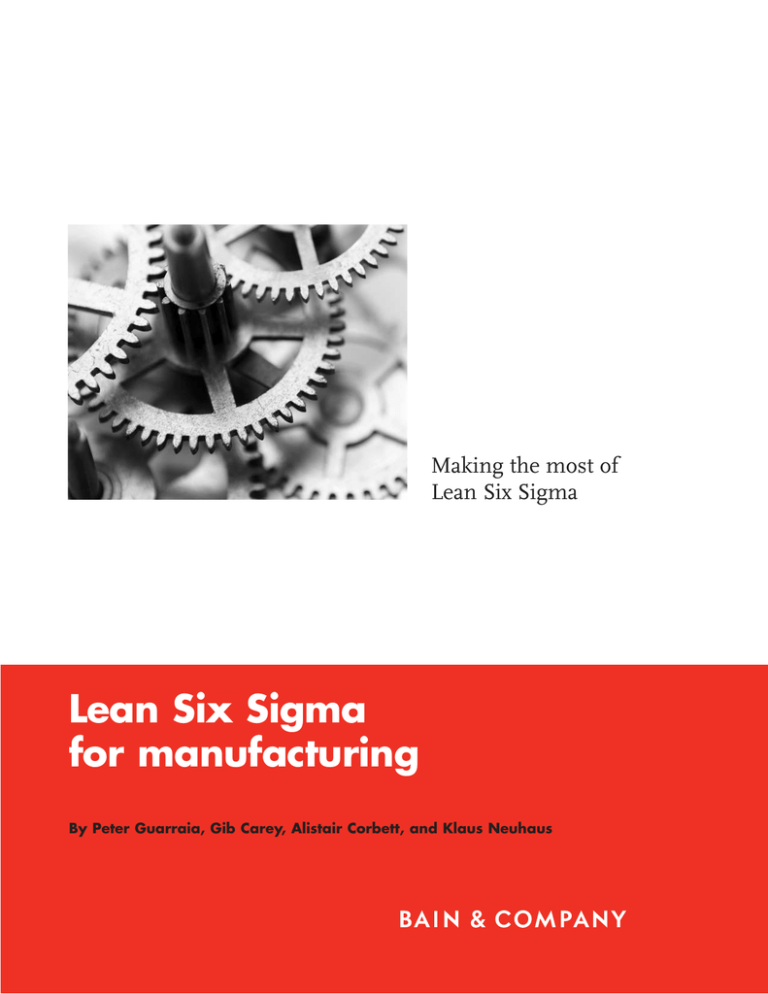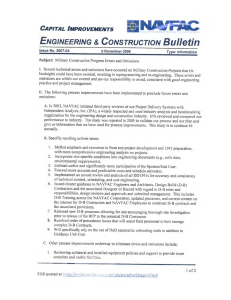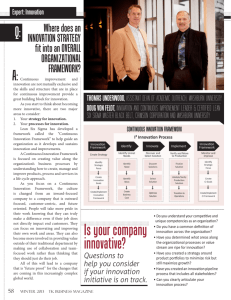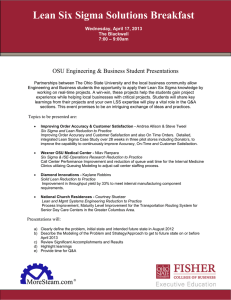
Making the most of
Lean Six Sigma
Lean Six Sigma
for manufacturing
By Peter Guarraia, Gib Carey, Alistair Corbett, and Klaus Neuhaus
Peter Guarraia is a partner in Bain & Company’s Los Angeles office,
Gib Carey is a partner in Chicago, Alistair Corbett is a partner in Toronto,
and Klaus Neuhaus is a partner in Düsseldorf.
Copyright © 2008 Bain & Company, Inc. All rights reserved.
Editorial team: David Diamond, Elaine Cummings
Layout: Global Design
Lean Six Sigma for manufacturing
Making the most of
Lean Six Sigma
Despite its popularity, Lean Six Sigma often
fails to deliver. Manufacturers are finding an
upfront diagnostic X-ray improves their odds
of streamlining operations and cutting costs.
As a methodology for improving both factory
output and quality, Lean Six Sigma (LSS) has
gained widespread popularity. The approach,
which aims to help companies create leaner
manufacturing operations and boost product
quality to no more than 3.4 defects per million opportunities, has delivered significant
improvements and cost savings at companies
as diverse as General Electric Co., Dell Inc.,
Xerox Corp., and Johnson & Johnson.
But for every Lean Six Sigma success story
there are tales of dissatisfaction. Many organizations have trained and deployed legions
of Lean Six Sigma experts, known as black
belts, only to see little value result from their
efforts. In a recent Bain & Company management survey of 184 companies, 80 percent
say their Lean Six Sigma efforts are failing to
drive the anticipated value, and 74 percent
say they are not gaining the expected competitive edge because they haven’t achieved their
savings targets.
Drilling deeper, we discovered that mobilizing large and costly squads of black belts in
some cases actually slows down performance
improvement efforts. Managers are unsure
how best to deploy the Lean Six Sigma experts
and too often black belts treat all problems,
big and small, with the same approach, resulting in less-effective solutions. Moreover, they
fail to prioritize the improvements that will
make the biggest difference.
This last issue is particularly vexing to companies as they search for ways to reduce
costs or boost revenues. While Lean Six
Sigma can be excellent at remedying obvious maladies like factory bottlenecks, it is
less adept at uncovering the hidden sources
of pain and identifying and sizing the largest
opportunities for cost savings, waste reduction, or revenue generation. It’s wasteful and
unnecessary to run every process through
Lean Six Sigma; knowing where to focus
before unleashing the black belts can make
all the difference.
We’ve found companies that are yielding the
biggest gains from Lean Six Sigma are deploying
an upfront diagnostic X-ray to help them identify
the most critical opportunities. Performed by a
small advance team of black belts, the diagnostic
X-ray consists of three steps:
1. Enterprise Value Stream Mapping, in which
the X-ray team scans the enterprise and maps
its primary processes to identify the biggest
opportunities to reduce cost by reducing wasted time and materials.
2. Benchmarking, in which the performance
of processes is measured against internal
and external benchmarks to measure shortcomings and establish performance-improvement targets.
3. Prioritizing, in which the X-ray team
determines which process improvements
will yield the greatest results when the Lean
Six Sigma teams are deployed.
Only after the X-ray has identified the most
pressing issues, do companies unleash the
black belts and begin the traditional five-step
Lean Six Sigma DMAIC process—Define,
Measure, Analyze, Improve, and Control—on
1
Lean Six Sigma for manufacturing
the targeted areas. For example, an X-ray
taken by an industrial equipment manufacturer of its manufacturing operations uncovered three processes ripe for improvement:
welding, painting, and deburring (removing
rough parts on metal). With these areas
identified and a Lean Six Sigma black belt
appointed to spearhead each initiative, the
company moved into the full DMAIC process.
In this case, the Define step, the first in the
DMAIC process, included the black belts taking a step back and identifying what needed
to be accomplished in the welding, painting,
and deburring processes—and what parts of
those processes they didn’t need. Ultimately,
the industrial company was able to reduce
the cost of producing each unit by over 15
percent and reduce the time it took to actually produce each unit by nearly 30 percent.
A diagnosis that identifies top priorities
To help fund innovation and roll out a promising new product line, a multibillion-dollar
consumer products manufacturer we’ll call
ConsumerCo urgently needed to increase
capacity at two of its plants and reduce overall operating costs. To determine where to
focus its efforts, the company added the
X-ray step and it paid off: the company
handily surpassed its goals for increasing
capacity and efficiency. At one plant alone,
ConsumerCo was able to reduce changeover
time on a key packaging machine from 12
hours to 20 minutes. This improvement
along with other similar changes added up
to a 15 percent reduction in the cost of
producing each package and a 25 percent
increase in capacity. The savings enabled
the company to fund innovation.
2
1. Enterprise value stream mapping
The first move taken by the X-ray team is to
develop a map of the operation’s processes
and the costs associated with them. The goal
is to understand what activities a company
performs and where inefficiencies or performance gaps might exist.
ConsumerCo’s X-ray team began its work
by mapping its production process, with the
aim of developing a comprehensive perspective on what the company was trying
to achieve in each manufacturing step—and
what activities were actually being performed.
In the value stream mapping process the team
worked on identifying capacity at each step,
understanding the relationships between the
steps, and hypothesizing about bottlenecks
and other sources of waste in the process.
In addition, the team culled data from the
machines themselves, as well as from direct
observation. That way, it was possible to see
both the performance gaps as well as the
wasted time and material in the process and
then start to break down the reasons: equipment not operating at full speed or not running due to breakdowns, changeover time,
or lack of raw materials. The plant finance
group helped the diagnostic team allocate
costs to each major process step. Some costs
were straightforward—like equipment-operator labor rates—while other costs needed
detailed investigation. For example, wasted
raw materials had to be measured at each step.
With the value-stream maps in hand, the
team could see where the biggest expenses
lay—and where improved performance would
deliver the greatest cost savings the fastest.
Lean Six Sigma for manufacturing
2. Benchmarking
the two facilities it hoped to improve against
the cost of producing a similar product at its
other plants. Not only did the exercise put
some hard figures to what the team already
suspected—costs were out of control at the
two facilities—but it also provided reasonable
targets for improvement.
Determining just how much performance
might be improved is the purpose of the second step of the X-ray. The aim of this phase is
to establish valid benchmarks, both external
and internal, for each process to identify
appropriate performance-improvement targets.
3. Prioritizing
In comparing its labor and asset productivity
with that of its lowest-cost US competitor,
ConsumerCo discovered that it needed to
make considerable gains to become competitive. The diagnostic team drew on its
members’ previous experiences outside the
company to assess the extent to which some
processes were underperforming.
In this final phase of the X-ray, the team decides
which problems to pursue in which order.
ConsumerCo’s X-ray team identified 45 possible performance-improvement initiatives
in its six-week scan of the business and then
ranked them according to their potential
for providing the greatest increase in output at the lowest cost in the shortest time.
Initiatives that tackled problems shared
across processes received a higher rank
because of their potential to improve multiple processes simultaneously.
In addition to gauging its performance
against these external benchmarks, the company looked inside its own walls for relevant
internal benchmarks. For instance, the team
compared the cost of producing a package at
Figure 1: Lean Six Sigma problem: many have adopted but few are satisfied with results
Many companies
have adopted Lean...
% of respondents* (N=668)
... but struggle to
achieve results
... and Six Sigma...
% of companies using
six sigma
% of companies that
strongly agree (N=182)
100%
100%
100%
80
80
80
60
60
60
49%
40
36%
40
36%
Total
40
26%
23%
20
20
0
Lean as primary plant
improvement method
0
20
Large Medium Small
(>$2B) ($.6B to (<$.6B)
$2B)
0
19%
Lean:
Our processes
involve minimal
nonvalueadded
activities
Six Sigma:
Our low defect
rate provides
competitive
advantage
*Note: Predominantly manufacturing companies; 25% with rev. > $100M, 75% below
Source: PI Diagnostic Survey, n=182; Tools and Trends Survey, n=960; 2005
IW/MPI Census of Manufacturers by Industry Week
3
Lean Six Sigma for manufacturing
In the end, the team whittled the list down
to just six that would have the most impact.
Initiatives with less promise or a high degree of
difficulty were put in a “parking lot” for future
consideration. The team also created a separate
group of initiatives that could drive further
improvements, but that would require senior
management’s input and capital investment.
Putting the Xray to work
With the X-ray complete, the company was
ready to apply Lean Six Sigma’s DMAIC
methodology to discover solutions to the
most pressing issues. ConsumerCo created
six LSS teams from a mix of plant staff and
black belts and charged each with implementing a specific initiative. The teams were
headed up by plant staff members, with the
black belts providing support and guidance,
and each had clear goals and metrics to
guide them in pursuing the potential gains
identified by the X-ray.
Team members made detailed observations
of their assigned process steps in order to
validate the X-ray findings—for example, that
packaging-line downtime was driven by three
specific factors: changeovers from one product mix to another, bottlenecks created by
maintenance problems, and line speed driven by product mix. They set about creating
workable solutions that would meet performance targets—for instance, altering
the changeover process to reduce downtime. The teams were directed to test out
these solutions as early as possible, and then
progressively refine them until they could be
rolled out to all shifts and to other lines with
similar equipment.
Leveraging Lean Six Sigma
ConsumerCo’s experience demonstrates
how the Lean Six Sigma methodology, when
paired with the diagnostic X-ray, becomes an
even more powerful tool. Originally conceived to streamline factory processes, reduce
waste, and improve quality, Lean Six Sigma
now is being used to help companies achieve
a range of other goals. The following four
case studies illustrate the breadth of Lean
Six Sigma’s possibilities—and the diagnostic
X-ray’s potential in helping deliver results.
Other ways to get more from Lean Six Sigma
1)
Put strong players on the LSS team and train them thoroughly. Assigning lessqualified peo
ple to the team because they happen to be available is a recipe for disaster. You want
strong, driven players who have credibility in the organization and will build momentum for
success. Make sure you give them adequate training; if they don’t know how to apply Lean
Six Sigma methodology, they won’t be able to do what you want them to.
2)
Check progress regularly and establish a few simple success metrics. There should be a
weekly meeting devoted to tracking dollars saved versus dollars invested, number of proj
ects or opportunities identified, and the number of issues resolved. A key question: Are the
savings generated showing up in the bottom line?
3)
Refocus the team if needed. Often, problems get resolved more quickly than expected
and don’t need team attention for as long as planned. Managers also need to continually
review LSS efforts to make sure the highestvalue opportunities are getting attention.
4
Lean Six Sigma for manufacturing
For an aircraft manufacturer: Reducing
inventory to improve cash flow
A major aircraft-parts manufacturer faced a
looming financial crisis and urgently needed
to free up more cash to invest in the business. The company was losing out on new
contracts because of high costs, largely due
to low inventory turnover. As a result, it was
losing money. While the aircraft-parts manufacturer knew that improving inventory
turnover was critical, it didn’t believe that
could be achieved without running low on
essential parts. The company’s inventory
turnover rate was 2.7x compared with its US
competitor’s 4x turnover rate. A diagnostic Xray quickly exposed a key fact: The low inventory turnover was just one symptom of broader inefficiencies in the management of its
parts supplies.
ply chain working more efficiently, the company was able to save another $20 million by
reducing its headcount. Once back on sound
financial footing, the aircraft-parts manufacturer was able to plow almost $200 million
back into the business to help regain its competitive edge.
For a circuitboard manufacturer:
Optimizing worldwide production
When a global circuit-board manufacturer
was acquired, the new private equity owners
set ambitious goals to improve financial performance. It was a major challenge since the
circuit-board manufacturer’s production plants
ranged widely in their performance—the US
plants were moneymakers, while the UK factory was in the red, and other plants weren’t
operating at full potential.
The diagnostic team started with a thorough
value stream mapping of the supply flow.
The mapping allowed the company to clearly
see the root causes that were driving up
expenses. Among the problems: too many
suppliers and a large support staff. Next, the
team used benchmarking to compare costs,
both internally and against industry standards. It showed that the employee headcount and overtime were about double the
US industry average. Initiatives then were
drawn up for each possible improvement
and prioritized based on cost savings that
each could produce. The company wanted to
use Lean Six Sigma to lower supply quantities, speed deliveries, and reduce factory-floor
delays. Finally, the diagnostic team tied each
initiative to metrics that allowed the company
to track progress against clear milestones.
To accelerate the Lean Six Sigma process, the
company decided to first perform a diagnostic
X-ray so that it could zero in on the root causes driving losses and determine which initiatives would deliver the strongest, and fastest,
financial results. The X-ray team started with
an enterprise value stream mapping of global
operations, spending 12 weeks observing production practices on the shop floor in each
plant, and gathering detailed data on staffing
and other performance indicators. It broke
out staffing for each part of the circuit-board
production process, allowing the team to see
how, with better production planning, the
company could trim employee costs. The
mapping also showed that circuit-board production was seriously hindered by unclean
conditions and cluttered, disorganized product processes and workplaces.
Only then were the black belts deployed on
the targeted areas. The approach improved
inventory turnover by 40 percent in two
years. It also freed up $100 million to $175
million in the first year alone. With the sup-
During the prioritizing phase, the X-ray team
developed five key initiatives to speed production and reduce costs by standardizing
steps in the production process. With these
standardized targets in place, employees at
5
Lean Six Sigma for manufacturing
every factory would be working toward the
same productivity targets. Some changes
were as straightforward as posting steps on
a bulletin board that employees should follow for keeping areas clean and organized.
The tightly focused initiatives helped make
the circuit-board manufacturer more competitive, efficient, and profitable. Over 12 months,
productivity at the US and German plants
improved by 24 percent and 19 percent, respectively; inventory was reduced by more than 55
percent, and the company closed its UK plant,
stemming the flow of red ink. For the new
private equity owners, the improvements in
global operations translated into more than a
seven-point increase in profits. Perhaps more
important, initially skeptical managers and
employees became believers and started setting ambitious improvement targets for the
following year.
For an industrial equipment manufacturer:
Quick ways to efficiency and savings
A large, international equipment manufacturer had tried unsuccessfully to use Lean Six
Sigma to combat quickly rising manufacturing costs. Its black belts’ efforts to improve
problematic assembly processes had made
minimal progress. Almost all parts were over
budget and behind schedule. To meet deadlines, the company was spending heavily on
rush deliveries, but even then assemblies
often did not get completed on time. As a
result, the equipment maker’s expenses were
double world-class best practices. When
launching a new process improvement campaign, the company wanted to prioritize its
efforts against areas of largest opportunity.
The diagnostic X-ray allowed the company to
shift from the theoretical to a concrete plan
of action for cost-saving initiatives, with the
diagnostic team creating a methodology for
identifying and testing solutions. In the value
6
stream mapping phase, industrial engineers
and subject matter experts spent more than
700 hours observing plant activities to pinpoint wasted time and ways to streamline
processes to reduce labor costs. Focusing on
component fabrication—an area of the plant
where parts were assembled—they walked
the plant floor, interviewing shop floor supervisors and gathering process flow information for each manufacturing step, plotting
the time spent and the resulting productivity.
Such detail allowed the X-ray team to benchmark processes and identify root causes of
the manufacturer’s soaring materials and
labor costs. For example, the mapping showed
that the major reason so many parts had to
be reworked was because too often they were
lost or damaged. The process also was slowed
because many parts weren’t made to the right
specifications and needed to be modified.
In addition, the team observed, identified
and began to isolate significant amounts of
non–value-added activities that were occurring in the production process. By comparing
procedures with best practices, the diagnostic
team created benchmarks for improvements
and tied them to performance measures so
they could be tracked.
The X-ray team prioritized possible improvements by weighing estimated future value
against ease of implementation. Those improvements with the highest overall payback went
to the top of the list. Finally, the team created
two tools to increase the effectiveness of the
black belts: a Savings Valuation Framework
to help prioritize future initiatives, and an
Optimal Lean Six Sigma structure that would
improve communication and skills and keep
work aligned with goals. With a clearly defined
action plan in hand, the company executed
eight process-improvement pilots and implemented successful initiatives, resulting in
labor savings of around 3.5 percent. Additionally,
Lean Six Sigma for manufacturing
they established a repetitive process of identifying, validating, and rolling out new initiatives that target 3 percent to 5 percent annual savings.
products or technology that could be licensed
or sold. The team also compared the laboratory operations to industry best practices at the
electronics company’s major competitors.
For an electronics market leader:
The mapping and benchmarking exposed
three major areas for improvement. First,
many large projects had little to do with the
electronic manufacturer’s major strategic initiatives—for example, only 37 percent of the
lab’s employees were working on innovations
related to the company’s top technology efforts.
Second, the research portfolio wasn’t as
future-focused as lab directors believed; only
a sliver of their budgets looked at innovations
five years out. Third, about 50 percent of the
time, lab directors picked ideas based on a
“gut feeling,” not a quantitative evaluation. In
general, the various labs were out of sync,
lacking common guidelines for selecting projects or consistent systems for ensuring that
they had strong support as they advanced
from concepts to product development.
Accelerating innovation
A major electronics manufacturer faced
competitive pressures to innovate faster,
more efficiently, and to consistently tie its
technology research to the company’s core
market strategy. To accelerate innovation
and improve performance, the company
embarked on a three-month diagnostic X-ray
aimed at ultimately redesigning ad hoc laboratory processes and better aligning research
projects to the needs of business units.
The X-ray team mapped three core research
processes: how researchers identified technology areas to investigate, allocated their
resources, and handed off technology projects as they moved through the R&D pipeline.
The analysis involved detailing how technology concepts were picked, how projects
were staffed at every step of the way, how
researchers decided to shelve or continue
researching an innovation, and what support was provided as projects were handed
off for development.
The mapping helped focus the X-ray team’s
benchmarking efforts on internal and external research capabilities. They compared each
company lab’s budget, how the labs prioritized projects, the mix and number of projects, their research strategies—especially time
spent investigating technology breakthroughs
versus technology improvements. They also
benchmarked average project timelines. To
gauge how often researchers selected highvalue projects, the X-ray team interviewed
business division managers, determining
which initiatives had evolved into hot-selling
Five major
reasons for
Lean Six
Sigma failures
• There’s a lack
of accountability
for aggregate
results, with
teams working
independently.
• Efforts aren’t tied
to corporate
goals, and
sponsorship is
diffused.
• The company
loses sight of the
goal in the heat
of training an
army of black
belts.
As diagnostic team members prioritized
solutions, they weighed each opportunity,
balancing potential improvements in research
performance against the cost. At the top of
the list of solutions: developing a centralized
technology strategy with corporate initiatives
guiding research project selection, funding,
and resource allocation. With investment
priorities at the corporate level, the electronics
manufacturer would better coordinate research
resources across the labs and align projects
with both lab and business unit needs. Another
priority: getting business units involved earlier
in the process. That way, researchers wouldn’t
waste time on ideas that lacked support. The
research organization and individual labs would
continue managing projects, but each undertaking would be regularly evaluated against
standardized performance benchmarks to
determine if it should move forward.
• The problem
returns after a
couple of years.
• Lean Six Sigma
efforts are wast
ed on areas that
will not make a
difference.
7
Lean Six Sigma for manufacturing
One of the most fundamental changes was
redefining the lab directors’ position to create
more visionary leadership. Instead of focusing on daily research, the directors would be
global managers, charged with scouting the
globe for futuristic technology trends and
rapidly developing leading-edge innovations.
And when they’d spot promising innovations, they would lead efforts to acquire them,
saving the company time wasted on re-inventing the technology.
With the completed X-ray in hand, black belts
set to work implementing the strategy and
process redesign over the next three months.
Once these were in place, the electronics
company was able to quickly innovate in
response to market demands. With a clearly
focused research strategy and streamlined
processes, the company has increased its
overall R&D spending, focusing more on cutting-edge and futuristic technologies. At the
same time, the electronics maker is optimizing its R&D dollars, saving costs through new
efficiencies, including outsourcing some work
to low-cost countries like India and Korea.
For an industrial supply company:
Redefining competition in the marketplace
8
After years as the market leader, the US division of an industrial supply company found
itself losing both money and its competitive
edge. The division had dropped from first to
third place and hadn’t posted a profit in five
years. With both investors and members of
the board of directors calling for dramatic
action, the industrial division needed to
quickly develop a turnaround strategy. But
first the company had to answer two questions: Was it realistic to expect improved
profits? If profits couldn’t be improved, then
should the parent company retain or sell off
the industrial supply division? Before taking
action, management decided to use the diagnostic X-ray to develop a data-driven analysis
of the division’s competitive position.
The diagnostic team tackled the key issues
in two phases. First, to create a fact-driven
market share analysis, it compared competitor returns against their market position and
then benchmarked their relative costs. The
team also looked at competitors’ plans to
increase capacity, conducted interviews with
them, and talked with division employees.
Second, it assessed the division’s prospects
for investing in a wholesale versus retail
channel, including a customer segmentation analysis, market-share forecasts and an
assessment of channel needs. Results from
this enterprise value stream mapping and
benchmarking allowed the team to create a
roadmap for cost savings and prioritize the
best opportunities for future growth.
They included closing the division’s most
expensive plants and replacing them with
plants offshore, a move that would reduce
costs by 15 percent to 20 percent. This was
a preemptive strike against competitors who
hadn’t begun to move production offshore.
All manufacturing and distribution operations embarked on a rigorous program of
process flow re-engineering to reduce cycle
times, working capital, and operating costs;
it resulted in substantial improvements in
all key metrics in these areas—inventory turns,
for example, more than doubled. And, to
restore its market leadership position, the
division would heavily invest in its retail
channel—the market analysis showed that
when compared to wholesale, the division
would be a stronger retail performer and
could take advantage of expected retail channel growth. Both strategic initiatives delivered a strong turnaround: profit margins
shot up from zero to 9 percent and the
industrial division’s market share grew from
14 percent to 17 percent. Such is the power
of a diagnostic X-ray.
Bain’s business is helping make companies more valuable.
Founded in 1973 on the principle that consultants must measure their success in terms
of their clients’ financial results, Bain works with top management teams to beat competitors
and generate substantial, lasting financial impact. Our clients have historically outperformed
the stock market by 4:1.
Who we work with
Our clients are typically bold, ambitious business leaders. They have the talent, the will
and the open-mindedness required to succeed. They are not satisfied with the status quo.
What we do
We help companies find where to make their money, make more of it faster and sustain
its growth longer. We help management make the big decisions: on strategy, operations,
technology, mergers and acquisitions, and organization. Where appropriate, we work with
them to make it happen.
How we do it
We realize that helping an organization change requires more than just a recommendation.
So we try to put ourselves in our clients’ shoes and focus on practical actions.
For more information, please visit www.bain.com
Amsterdam • Atlanta • Beijing • Boston • Brussels • Chicago • Copenhagen • Dallas • Dubai • Düsseldorf • Frankfurt • Helsinki • Hong Kong
Johannesburg • Kyiv • London • Los Angeles • Madrid • Melbourne • Mexico City • Milan • Moscow • Munich • New Delhi • New York
Palo Alto • Paris • Rome • San Francisco • São Paulo • Seoul • Shanghai • Singapore • Stockholm • Sydney • Tokyo • Toronto • Zurich







